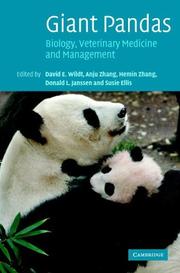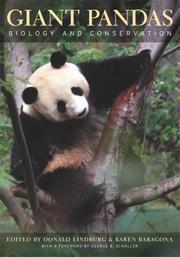| Listing 1 - 8 of 8 |
Sort by
|
Book
ISBN: 9780199393671 9780197533574 9780199393701 Year: 2020 Publisher: New York Oxford University Press
Abstract | Keywords | Export | Availability | Bookmark
 Loading...
Loading...Choose an application
- Reference Manager
- EndNote
- RefWorks (Direct export to RefWorks)
'Panda Nation' demonstrates how the giant panda's transformation from an obscure animal into a national treasure reflects China's efforts to distinguish itself as a nation. Through government-directed science and popular nationalism, the story of the panda's iconic rise offers a striking reflection of China's dramatic ascent in global status.
Pandas --- Pandas --- Pandas --- Symbolic aspects. --- Political aspects. --- Conservation.
Book
ISBN: 0199393672 0199393680 0199393699 0199393702 9780199393688 9780199393701 9780199393695 9780199393671 9780197533574 Year: 2018 Publisher: New York, NY
Abstract | Keywords | Export | Availability | Bookmark
 Loading...
Loading...Choose an application
- Reference Manager
- EndNote
- RefWorks (Direct export to RefWorks)
'Panda Nation' demonstrates how the giant panda's transformation from an obscure animal into a national treasure reflects China's efforts to distinguish itself as a nation. Through government-directed science and popular nationalism, the story of the panda's iconic rise offers a striking reflection of China's dramatic ascent in global status.
Pandas --- Symbolic aspects. --- Political aspects. --- Conservation.

ISBN: 9780511542244 9780521832953 9781107411555 9780511242403 0511242409 0511240554 9780511240553 0511241070 9780511241079 0511241593 9780511241598 1280568119 9781280568114 0521832950 0521832950 1107148987 9781107148987 9786610568116 6610568111 0511312121 9780511312120 0511542240 1107411556 Year: 2006 Publisher: Cambridge Cambridge University Press
Abstract | Keywords | Export | Availability | Bookmark
 Loading...
Loading...Choose an application
- Reference Manager
- EndNote
- RefWorks (Direct export to RefWorks)
The giant panda is one of the world's most recognized animals. With the environment undergoing unprecedented change at a rapid and accelerating rate, can such a highly specialized species survive? This 2006 book summarizes panda biology and encompasses topics such as reproduction, behaviour, nutrition, genetics and veterinary medicine. It also provides information on veterinary management, advances in neonatal care, disease detection and prevention and the use of 'assisted breeding' to promote reproduction and preserve genetic diversity, as the females are sexually receptive for only 3 days per year and generally produce twins, but often lose one due to maternal neglect. This book provides the scholarly knowledge that will help conserve this treasured species in nature, while there is still time.
Giant panda. --- Ailuropoda. --- Bears --- Pandas --- Ailuropoda melanoleuca --- Ursus melanoleucus --- Ailuropoda
Book
ISBN: 1523147407 1683928180 1683928199 Year: 2022 Publisher: Bloomfield : Mercury Learning & Information,
Abstract | Keywords | Export | Availability | Bookmark
 Loading...
Loading...Choose an application
- Reference Manager
- EndNote
- RefWorks (Direct export to RefWorks)
As part of the best-selling Pocket Primer series, this book is designed to introduce the reader to the basic concepts of managing data using a variety of computer languages and applications. It is intended to be a fast-paced introduction to some basic features of data management and covers statistical concepts, data-related techniques, features of Pandas, RDBMS, SQL, NLP topics, Matplotlib, and data visualization. Companion files with source code and color figures are available. FEATURES: Covers Pandas, RDBMS, NLP, data cleaning, SQL, and data visualization. Introduces probability and statistical concepts. Features numerous code samples throughout. Includes companion files with source code and figures.
Quantitative research --- Reliability. --- Data processing. --- NLP. --- Pandas. --- RDBMS. --- SQL. --- computer science. --- data analytics. --- data cleaning. --- data visualization. --- programming. --- python. --- statistics.

ISBN: 9786612357190 0520930169 1282357190 1597346330 9780520930162 9781597346337 9780520238671 0520238672 1417545259 9781417545254 0520238672 6612357193 9781282357198 Year: 2004 Publisher: Berkeley University of California Press
Abstract | Keywords | Export | Availability | Bookmark
 Loading...
Loading...Choose an application
- Reference Manager
- EndNote
- RefWorks (Direct export to RefWorks)
The much-loved giant panda, a secretive denizen of the dense bamboo forests of western China, has become an icon worldwide of progress in conservation and research. This volume, written by an international team of scientists and conservationists including Chinese researchers whose work has not been available in English, tells the promising story of how the giant panda returned from the brink of extinction. The most important sourcebook on giant pandas to date, it is the first book since 1985 to present current panda research and the first to place the species in its biological, ecological, and political contexts. More than a progress report on a highly endangered species, Giant Pandas: Biology and Conservation details the combination of scientific understanding, local commitment, and government involvement that has been brought into play and asks what more needs to be done to ensure the panda's survival. The book is divided into four parts-Evolutionary History of the Giant Panda, Studies of Giant Panda Biology, Pandas and Their Habitats, and Giant Panda Conservation. It combines the latest findings from the field and the laboratory together with panel and workshop summaries from a recent international conference. Taken together, the chapters highlight how international cooperation has led to better management in the wild and in captivity. The volume also shows how concepts such as buffer zones, links between forest fragments, multiple-use areas, and cooperation with local people who have a stake in the resources-highly relevant concepts for conservation problems around the world-have been key to the panda's survival.
Giant panda. --- Giant panda --- Ailuropoda melanoleuca --- Ursus melanoleucus --- Ailuropoda --- Conservation. --- animal behavior. --- animal population. --- animals in captivity. --- asia. --- bamboo. --- biology. --- breeding. --- chengdu zoo. --- china. --- conservation. --- ecology. --- environment. --- environmentalism. --- extinction. --- foping nature reserve. --- giant pandas. --- habitat. --- mabian nature reserve. --- mountains. --- natural science. --- paleontology. --- population decline. --- qinling mountains. --- red pandas. --- reintroduction. --- reproduction. --- science. --- supertree. --- ursidae. --- wild animals. --- wildlife. --- yele nature reserve. --- zoo animals. --- zoo atlanta. --- zoology.
Book

ISBN: 0191008591 0191008583 0191820709 9780191008580 9780191820700 9780198703549 0198703546 9780198703556 0198703554 Year: 2016 Publisher: Oxford
Abstract | Keywords | Export | Availability | Bookmark
 Loading...
Loading...Choose an application
- Reference Manager
- EndNote
- RefWorks (Direct export to RefWorks)
This text brings together the latest research on coupled human and natural systems (CHANS), featuring a classic long-term interdisciplinary research project and model coupled human-nature system - the Wolong Nature Reserve of China, which contains one of the largest populations of the world-famous endangered giant pandas.
Giant panda --- Human-animal relationships. --- Nature --- Conservation --- Effect of human beings on. --- Pandas. --- Nature conservation --- Human ecology --- Ecosystem management --- Adaptation (Biology) --- Grand panda. --- Espaces naturels --- Écologie humaine --- Gestion des écosystèmes --- Adaptation (biologie) --- Protection
Book
ISBN: 3039210912 3039210904 Year: 2019 Publisher: MDPI - Multidisciplinary Digital Publishing Institute
Abstract | Keywords | Export | Availability | Bookmark
 Loading...
Loading...Choose an application
- Reference Manager
- EndNote
- RefWorks (Direct export to RefWorks)
Major depression and obsessive–compulsive disorder (OCD) are now recognized among the most frequent psychiatric disorders, affecting 16–17% and 2–3% of the general population, respectively. They are commonly characterized by: i) a high level of psychiatric and somatic comorbidities; ii) a recurrence or chronic profile; and iii) a negative impact on daily functions, thereby leading to a profound impairment of quality of life. Despite significant advances in pharmacological and psychological therapies over the last decades, unsuccessful responses to standard treatment strategies are classically observed in approximately 20–30% of cases. Therefore, there is a significant need for improving the pathophysiological knowledge through a better identification of environmental, clinical, psychological, genetic, anatomical, and biological determinants, specifically implied in the development, the phenotypic expression, and the relapsing course and/or contributing to the therapeutic failure in major depression and OCD. We are convinced that this research approach is particularly relevant providing critical support for the promotion of innovative treatment alternatives potentially useful for the management of resistant forms of major depression and OCD.
n/a --- i-health --- olfaction --- psychiatry --- obsession --- obsessive–compulsive disorder --- transcranial direct current stimulation --- ecological momentary assessment --- Streptococcus pyogenes --- cytokines --- immunology --- compulsion --- cognition --- nosography --- pediatric autoimmune neuropsychological disorders associated with streptococcal infection (PANDAS) --- symptoms networks --- brain stimulation --- neuromodulation --- OCD --- m-health --- categorizations --- ecological momentary intervention --- fictional case study --- pediatric acute-onset neuropsychiatric syndrome (PANS) --- Toxoplasma gondii --- tDCS --- therapeutic tool --- depression --- markers --- quality of life --- Tourette syndrome --- Obsessive-compulsive disorder. --- Depression, Mental. --- Dejection --- Depression, Unipolar --- Depressive disorder --- Depressive psychoses --- Melancholia --- Mental depression --- Unipolar depression --- Affective disorders --- Neurasthenia --- Neuroses --- Manic-depressive illness --- Melancholy --- Sadness --- Compulsive disorder --- Fixed ideas --- Obsession (Psychology) --- Obsessive-compulsive neuroses --- Obsessive-compulsive neurosis --- OCD (Disease) --- Compulsive behavior --- Bipolar disorder --- obsessive-compulsive disorder
Book
Year: 2022 Publisher: Basel MDPI Books
Abstract | Keywords | Export | Availability | Bookmark
 Loading...
Loading...Choose an application
- Reference Manager
- EndNote
- RefWorks (Direct export to RefWorks)
This collection of articles provides an overview of the current and future methods for applying a personalized medicine approach to the diagnosis, management, and treatment of autism spectrum disorder.
fecal metabolites --- ASD --- microbiome --- gastrointestinal symptoms --- Fisher Discriminant Analysis --- digital biomarkers --- wearables --- time series analysis --- autism --- social dyads --- socio-motor parameters --- network connectivity --- non-linear complex dynamics --- stochastic analysis --- autism spectrum disorders --- copy number variants --- females --- Array-Comparative Genomic Hybridization (Array-CGH) --- autism spectrum disorder --- Ehlers-Danlos syndrome --- hypermobility spectrum disorders --- autonomic disorder --- mast cell activation syndrome --- genetic testing --- chromosomal microarray analysis --- whole exome sequencing --- whole genome sequencing --- clinical utility --- polygenic risk scores --- Temple Grandin --- biomarker --- omics --- precision medicine --- proteomics --- transcriptomics --- epigenetics --- metabolomics --- patient stratification --- mitochondria --- oxidative stress --- prenatal environment --- immune dysfunction --- immunoglobulin G --- intravenous immunoglobulin --- energy metabolism --- fatty acid oxidation --- acyl-carnitines --- resveratrol --- integrative --- model --- concomitant --- condition --- disorder --- autism spectrum disorder (ASD) --- genomics --- personalized treatment strategy --- single nucleotide polymorphisms --- clinical decision support tool --- ADHD --- PANDAS --- OCD --- anxiety --- folate receptor alpha --- folates --- pregnancy --- brain development --- fetal development --- cobalamin --- glutathione --- methylation --- methylcobalamin --- redox metabolism --- locked-in network syndrome --- resting-state functional magnetic resonance imaging --- temporal lobe epilepsy --- amygdala --- brain --- COVID-19 --- children --- cytokines --- flavonoids --- inflammation --- luteolin --- mast cells --- microglia --- SARS-CoV-2 --- stress --- nutraceuticals --- survey --- vitamins --- minerals --- B12 --- folinic acid --- quality of life --- parents --- intervention --- systematic review --- medical claims --- logistic regression analysis --- retrospective analysis --- associated risk --- monoamine neurotransmitters --- neurotransmitter deficiency --- cerebral folate deficiency --- folate receptor alpha autoantibodies --- leucovorin --- α-amylase --- cortisol --- heart rate variability --- neuromodulation --- sleep anxiety --- transdermal electrical neuromodulation --- neurostimulation --- n/a
| Listing 1 - 8 of 8 |
Sort by
|

 Search
Search Feedback
Feedback About UniCat
About UniCat  Help
Help News
News